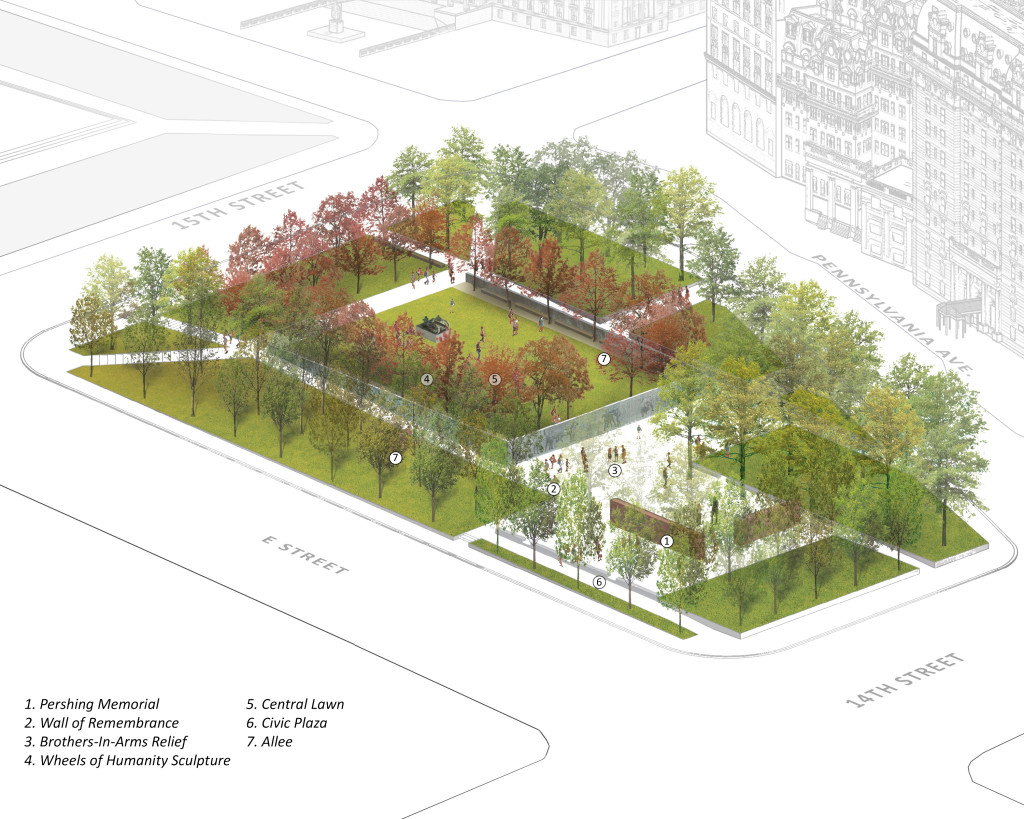February 4, 2016
How A 25-Year-Old Architect-In-Training Won The World War I Memorial Competition

The design concept for "The Weight Of Sacrifice" by Joe Weishaar and Sabin Howard.
In 2015, Kojo Nnamdi spoke with architect Roger Lewis about the future of Pershing Park, a small plaza near the White House that is slated to become the home of a new memorial honoring those who served in World War I.
The World War I Centennial Commission announced the winner of the competition to design that memorial last week, and rather surprisingly, the selected design came from Joseph Weishaar, a 25-year-old architect-in-training from Chicago. His design, entitled The Weight of Sacrifice, transforms Pershing Park into a functional yet reflective space to honor those who fought for the United States nearly 100 years ago.
Producer Raynell Cooper talked to Weishaar about the competition process and his process in developing the design for the site.
How did you end up submitting a design to this competition despite the odds of someone as young as you getting the selection?
You have to hope when you enter a competition that it’s going to go somewhere; otherwise, there’s not a huge point in entering. So I was maybe one-in-a-million, but at least I had that chance. And a big part of that came from the fact that they opened this competition up to everybody. They really wanted the design to come from the American people and not just professionals. They were hoping that maybe it would be some five-year-old with a crayon drawing who had the next great memorial idea.
From a memorializing standpoint, what do you think set your design apart from the other entries?
I really think it was the sculpture that set us apart. Because we had very real figures, nothing abstract (at least in the sculptural portion), we feel it can more clearly give a narrative of the war and communicate our ideas. We’re trying to create a memorial that is more about humanity and the struggles people faced in the war than it is about the war itself. And we’re not trying to glorify warfare, we’re trying to glorify the individuals and the collective who really fought and I think bringing people and the human aspect in the design is what will continue to draw people to the memorial once it’s built and will resonate with people for years to come.
This is going to be a big draw for tourists and people reflecting on the sacrifices of the soldiers. But it’s also right in downtown Washington, D.C. How do you envision everyday Washingtonians who work in the area using the space?
That’s a very big part of it, figuring out how to separate the functions of a park into something that’s kind of your everyday park and what’s the memorial. The way people use public space in this country, we’re very accustomed to using the edge of a space because we want to see and be seen and engage with public life. So the edges of the design are really that space where people come and sit on the bench and eat their lunch or just hang out and then the center of the park becomes the memorial.
You didn’t make any visits to D.C. until you became a finalist in the competition. How were you able to get a feel for the site and the city remotely?
A lot of research. Thankfully, Google Maps is this amazing thing we have, but even that doesn’t really communicate how people use a place. But tapping into things like videos online that someone may have shot a bit of the park over their shoulder or on a newscast, you can see how people use the space and move into it.
Did your perspective or the design change once you visited D.C. and saw the site?
It did, and every time I visited it kept changing a little bit more and I’d notice something extra. One time I went, I saw that people sat along the top edge of the park but they don’t sit down in the steps. So getting to see those things started to influence how and where different pieces of the design fit.
There’s been some vocal support for the current design of Pershing Park but you’ve chosen to change the space quite a bit. What are some of the drawbacks of the way the space is now and the way it’s been kept up over the years?
The park works in certain aspects so I don’t think it’s a bad design, at least in most areas. What I think doesn’t work is having the sunken center. When this park was designed, all around the country you had spaces like Rockefeller Center, very successful sunken spaces. At the time, this was an accepted way to keep people sheltered from the bustle of the city and make them feel a little bit protected. Now, places like that start to feel isolated and cut-off from the surroundings. So the design tries to fix that problem, and by raising the center of the park you can try to reverse that condition.
Last question: What’s your favorite memorial that’s already been built in D.C. and why?
I’m a big fan actually of the Franklin Delano Roosevelt Memorial because of the way each of the spaces is segmented. It’s really about a narrative path through the memorial and really takes on more of a park-like aspect that the other memorials don’t have.
The World War I Memorial And The Art Of Remembrance – The Kojo Nnamdi Show


